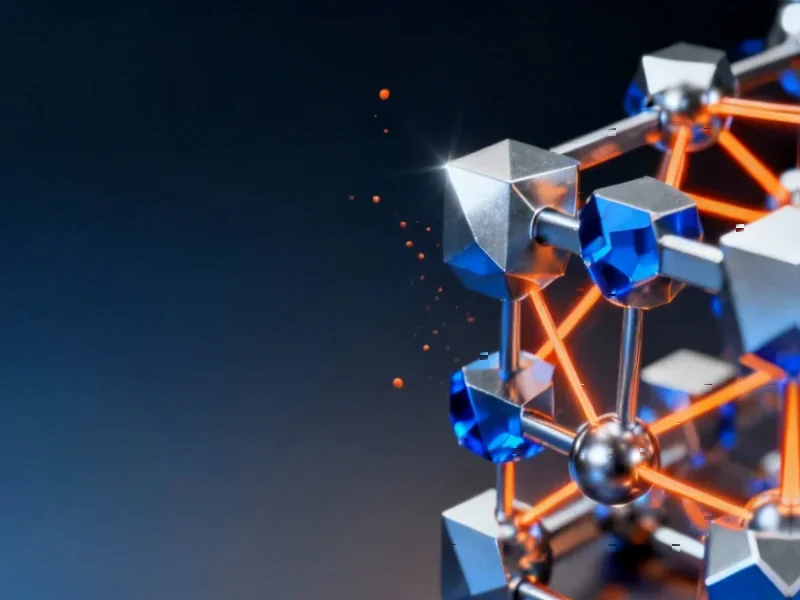According to Nature, computational research published in Scientific Reports reveals that selenium-doped nitrogen-graphene nanoflakes (SeNGr) demonstrate superior catalytic performance for CO2 hydrogenation and electrochemical reduction compared to tellurium-doped counterparts. The study found SeNGr exhibits significantly lower activation energies – just 0.09 eV for initial hydrogen adsorption versus 1.11 eV for TeNGr – and more favorable formation energies of -2.26 eV compared to -1.97 eV for TeNGr. SeNGr also showed stronger adsorption capabilities with hydrogen adsorption energy of -0.33 eV and CO adsorption energy of -0.28 eV, along with more efficient product desorption with Gibbs free energy of -0.79 eV. The research identifies SeNGr’s shorter bond lengths (2.09 Å versus 2.19 Å for TeNGr) and superior electronic properties as key factors enabling its exceptional performance in converting CO2 to formic acid and methanol through metal-free catalysis.
Table of Contents
The Metal-Free Catalyst Revolution
The search for alternatives to precious metal catalysts represents one of the most critical challenges in sustainable chemistry. Traditional catalysts using platinum, palladium, or ruthenium have dominated CO2 conversion processes, but their scarcity and cost create fundamental scalability limitations. What makes this selenium-doped graphene breakthrough particularly significant is how it addresses both economic and environmental constraints simultaneously. Unlike metal-based systems that often require complex synthesis and purification processes, graphene-based materials can be produced through relatively straightforward chemical vapor deposition or solution-based methods. The activation energy barriers reported for SeNGr – substantially lower than many metal catalysts – suggest we might be approaching a tipping point where metal-free systems can compete on pure performance metrics rather than just cost or sustainability arguments.
The Electronic Architecture Advantage
What’s truly revolutionary about this research isn’t just the performance numbers but the underlying electronic mechanism enabling them. The selenium doping creates precisely tuned electronic states near the valence and conduction bands that facilitate charge transfer without the typical drawbacks of metal catalysts. The +0.47 e charge on selenium atoms creates an electrostatic environment perfectly suited for interacting with CO2 molecules, while the surrounding nitrogen framework provides stability. This represents a fundamental advance in catalyst design philosophy – instead of relying on expensive metals with inherent catalytic properties, researchers are now engineering specific electronic environments within carbon matrices to achieve targeted reactivity. The 2.09 Å Ångström bond lengths between selenium and nitrogen create an optimal geometric configuration that maximizes both stability and accessibility for reactant molecules.
Scaling Challenges and Real-World Implementation
While the computational results are compelling, several significant hurdles remain before selenium-doped graphene catalysts see widespread commercial application. The synthesis of precisely controlled pyridinic nitrogen vacancies with single-atom selenium doping represents a substantial manufacturing challenge at scale. Current methods for creating such specific defect structures work well in laboratory settings but lack the reproducibility and cost-effectiveness needed for industrial deployment. Additionally, the long-term stability of these materials under real electrochemical conditions remains unproven. The favorable desorption energies are promising, but catalyst poisoning from impurities or gradual degradation of the graphene structure could limit practical lifespan. The research also doesn’t address how these catalysts perform in flow reactors or under continuous operation conditions where mass transport limitations often become dominant factors.
Broader Industrial and Environmental Implications
The potential impact of efficient metal-free CO2 conversion catalysts extends far beyond academic interest. Industries ranging from energy storage to chemical manufacturing could be transformed by cost-effective carbon utilization technologies. The ability to convert CO2 into formic acid and methanol at low overpotentials opens possibilities for integrated carbon capture and utilization systems that could fundamentally change the economics of emissions reduction. The charge transfer characteristics that make SeNGr effective for CO2 reduction likely extend to other important reactions, suggesting a platform technology approach rather than a single-application solution. The charge-transfer complex formation capabilities demonstrated in this research could be engineered for various electrochemical transformations, potentially creating a new class of carbon-based catalysts to replace metals across multiple industrial processes.
The Road to Commercialization
Looking forward, the most immediate application likely lies in specialized electrochemical reactors for high-value chemical production rather than bulk fuel synthesis. The combination of moderate binding strength and pronounced activation makes SeNGr particularly well-suited for processes requiring precise control over reaction pathways. The next critical research phase should focus on demonstrating these catalysts in integrated systems rather than isolated reactions, examining how they perform alongside separation technologies and in multi-step synthesis processes. The substantial performance advantage over tellurium-doped systems also suggests that further exploration of the chalcogen series – particularly sulfur and selenium analogs – could yield even more optimized catalysts. As manufacturing techniques for precisely doped graphene materials continue advancing, we may see the first commercial applications of these metal-free catalysts within 3-5 years, initially in niche applications before broader adoption in carbon utilization infrastructure.
Related Articles You May Find Interesting
- The AI Medical Team: How Multi-Agent Systems Are Revolutionizing Healthcare
- The Great American Surveillance Paradox: Profits vs. Principles
- Apple’s Legal Reprieve in AirPods Pro Case Signals Broader Industry Pattern
- Graphene’s Quantum Leap: Mapping the Entropy of Nanoscale Pores
- The Success Trap: Why Yesterday’s Wins Are Today’s Biggest Threat



